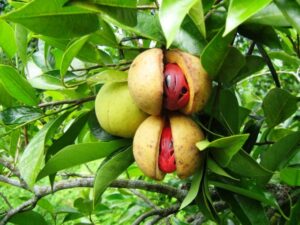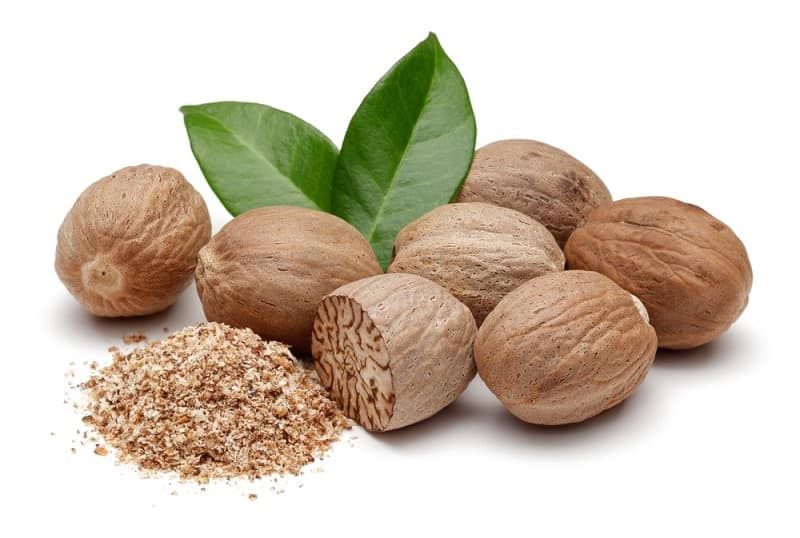Herb
Jatiphala (Myristica fragrans) Herb Ayurvedic Overview
Jatiphala is a classical Ayurvedic herb known to be digestive tonic, aphrodisiac, beneficial in Kasa, Swasa, Shiroshoola, etc. In Ayurvedic textbooks and journals, Jatiphala is of many valuable properties such as Laghu, Deepana, Rochana, Tikshana, Hrudya, Trushnapaha, Vata Atisarahara, and Vrushya.
Jatiphala consists of the endosperm of dried seeds (kernels of fruits) of Myristica fragrans Houtt. (Fam. Myristicaceae), dioecious or occasionally monoecious aromatic tree, about 10-20 m high, found mainly in Tamil Nadu and to some expanse in Kerala, Andhra Pradesh, and Assam. For ages, Jatiphala has been used as a home remedy for various complications. Jatiphala, often also called Jaiphala, helps reduce inflammation and is beneficial in joint pain. It is used to provide mild, warm, and sweet fragrances to the dishes.
Table of Contents
Scientific Classification of Jatiphala (Myristica fragrans):
- Kingdom: Plantae
- Subkingdom: Tracheobionta
- Superdivision: Spermatophyta
- Division: Magnoliophyta
- Class: Magnoliopsida
- Subclass: Magnoliidae
- Order: Magnoliales
- Family: Myristicaceae
- Genus: Myristica
- Species: Fragrans
Jatiphala (Myristica fragrans) Synonyms:
- Sanskrit: Jatisasya, Jatiphala
- Assamese: Jaiphal, Kanivish
- Bengali: Jaiphala, Jaitri
- English: Nutmeg
- Gujrati: Jaiphala, Jayfar
- Hindi: Jaiphal
- Kannada: Jadikai, Jaykai, Jaidikai
- Kashmiri: Jafal
- Malayalam: Jatika
- Marathi: Jaiphal
- Oriya: Jaiphal
- Punjabi: Jaiphal
- Tamil: Sathikkai, Jathikkai, Jatikkai, Jadhikai, Jadhikkai
- Telugu: Jajikaya
- Urdu: Jauzbuwa, Jaiphal
Jatiphala (Myristica fragrans) Description:
 a) Macroscopic: Seed of Jatiphala are ellipsoid, 20-30 mm long and is about 20 mm broad. It is externally greenish-brown, occasionally marked with small irregular dark brown patches or minute dark points and lines slightly creased reticulate.
a) Macroscopic: Seed of Jatiphala are ellipsoid, 20-30 mm long and is about 20 mm broad. It is externally greenish-brown, occasionally marked with small irregular dark brown patches or minute dark points and lines slightly creased reticulate.
A small light-colored area at one end indicating the position of the radical, a groove running beside the line of raphe to darker chalaza at the opposite end, adjoined by a thin layer of perisperm with in folding appearing as dark ruminations in the abundant grayish-brown endosperm, embryo, in an irregular cavity, which is small with two widely spreading crumpled cotyledons and a small radical odor is strong and aromatic. The taste is pungent and aromatic.
b) Microscopic:Transverse section of endosperm represented peripherally perisperm, several layers of strongly and flattened polyhedral cells with brown contents, or containing prismatic crystals. The inner layer of the perisperm of thin-walled parenchyma is about forty µ thick, engulfing into the tissue of the endosperm to structure the ruminations.
It is holding numerous, huge 69 oil cells with brown cell walls, vascular strands in the peripheral region, multiple small spiral vessels, large celled, endosperm, parenchymatous with random tannin idioblasts with thin brown walls which contains a plethora of simple, rounded, and compound starch grains, with up to about ten components, usually 2-8 individual grains, up to twenty µ in diameter present, most of the cells with crystalline fat and frequently a large aleurone grain in each cell, containing a rhombic protein crystal up to twelve µ and small aleurone grains with slightly regular crystalloids, embryo, of shriveled and collapsed parenchyma.
Identity, Purity, and Strength of Jatiphala (Myristica fragrans):
- Foreign matter Not more than 1 percent, Appendix 2.2.2.
- Total Ash Not more than 3 percent, Appendix 2.2.3.
- Acid-insoluble ash Not more than 0.5 percent, Appendix 2.2.4.
- Alcohol-soluble extractive Not less than 11 percent, Appendix 2.2.6.
- Water-soluble extractive Not less than 7 percent, Appendix 2.2.7.
- Ether soluble extractive Not less than 25 percent, Appendix 2.2.8
- Volatile oil Not less than 5 percent, Appendix 2.2.10
Chemical Constituents of Jatiphala (Myristica fragrans):
Jatiphala consists of much essential oil and fixed oil. It contains Beta Pipeline, Safrole, Alpha Terpinene, Methyl Eugenol, Myristic acid, Lignans, and neolignans.
Ayurvedic Properties and Action of Jatiphala (Myristica fragrans):
- Rasa: Katu, Tikta
- Guna: Laghu, Tiksna
- Virya: Usna
- Vipaka: Katu
- Karma: Dipana, Grahi, Vrsya, Mukhakledanasaka, Mukhadaurgandhyanasaka, Kaphavatapana
Ayurvedic Formulations made by Jatiphala (Myristica fragrans):
Jatiphala is used in various Ayurvedic formulations such as Jatiphaladi Churna, Dadimavaleha, Mrita Sanjivani Gutika, and Nasika Churna.
Therapeutic Uses of Jatiphala (Myristica fragrans):
Jatiphala can be used in Atisara, Svasa, Chardi, Kasa, Pinasa, Grahani, Mukharoga, Sukrameha.
Dose of Jatiphala (Myristica fragrans):
0.5 – 1.0 g of the drug in powder.
Reference:
Ayurvedic Pharmacopeia of India.


